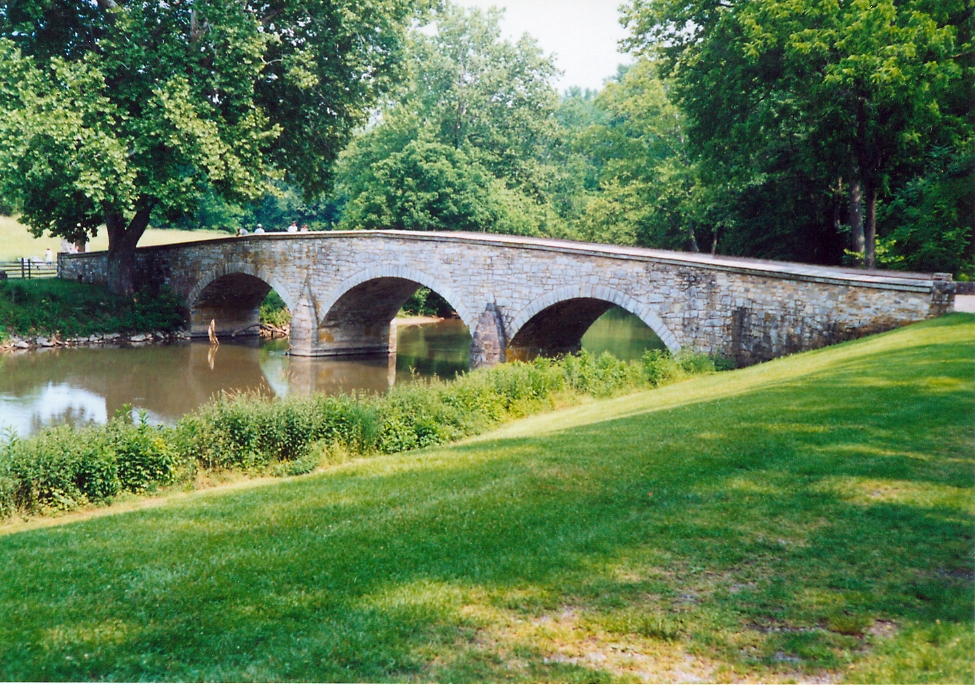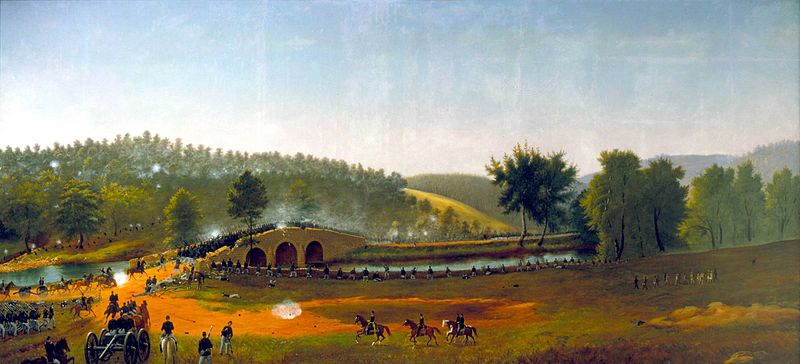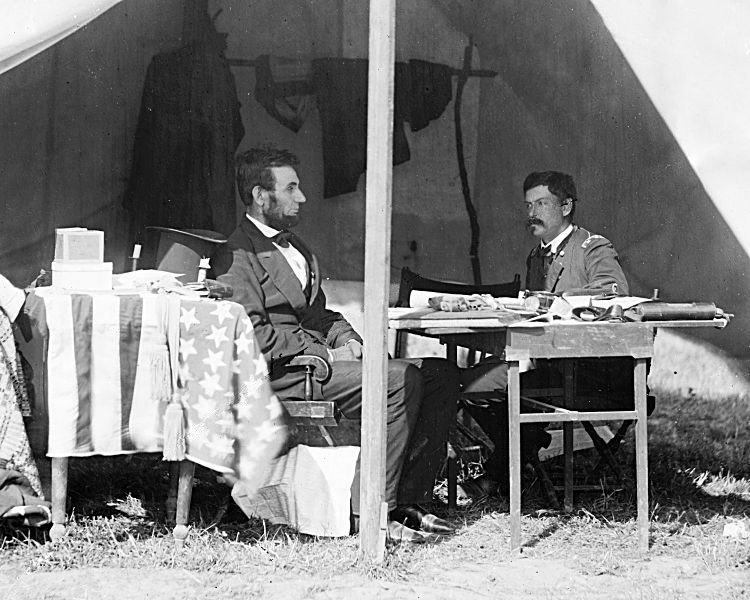
As the fighting around the Sunken Road died down on the Confederate right the battle continued. Burnside had been ordered to make a crossing of the creek and assault the Confederate line. Although he started early in the morning, not a man of his command had crossed the bridge before the battles on the left and center had wound down. Burnside had over 12,000 men and 50 cannon. All the Confederates had to stand up to him on the wide front to the right of D. H. Hill was the division of D. R. Jones. He had only 3,000 men and 12 cannon. All the rest of the troops in the area had been rush to the left to meet the attacks of Hooker, Sumner and Mansfield. The only troops positioned to guard the actual crossing was the 400 man brigade of Richard Toombs. The rest of Jones's force was positioned on Cemetery Ridge to the West. Toombs however held a strong position. At this point 100 foot bluffs rose very close to the creek, creating a good defensive position. Burnside focused his efforts to cross the creek on the lower or Rohrback's bridge, which would later be renamed after Burnside. The road ran along the side of the creek towards the bridge, giving the Confederates amble time to pick off advancing bluecoats. The creek at this point is only 50 feet wide, and there were many places Burnside could have sent his men across without being subjected to the Confederate fire. But while he did send a division down stream to look for a crossing point, he still spent much time and blood attempting to force this bridge. Henry Kyd Douglas, a staff officer for Stonewall Jackson, wrote this:
Since early morning General Ambrose E. Burnside with a crops of 13,000 men had been lying on the opposite side of the Antietam, looking for an opportunity to get across a bridge, which is now - is it sarcasm? - called Burnside's Bridge. Why the bridge? It was no pass of Thermopylae. Go look at it and tell me if you don't think Burnside and his corps might have executed a hop, skip and up and landed on the other side. One thing is certain, they might have waded it that day without getting their waist belts wet in any place.

None the less at 10 am Burnside began sending his troops forward in an attempt to capture the bridge. He planned or the 11th Connecticut to cover the bridge with their fire while a brigade from Ohio under Colonel George Crook would charge across. When the 11th Connecticut was opened on by Toomb's men within 15 minutes they were in retreat, having lost 140 men, a third of their strength. Meanwhile Crook's brigade got lost and never made it to the bridge. The attack was a decided failure. Burnside ordered another attack at 10:45, for the 16th New Hampshire and 2nd Maryland to charge down the road along the creek and across the bridge. One man of the 6th New Hampshire recorded the battle:
The road occupied by our troops came down to the creek nearly three hundred yards below the bridge; thence, turning at right angles, it ran along the bank, with only the narrow stream between it and the enemy's position, and then turned again at right angles to cross the bridge. The opposite bank was a steep, high bluff, covered on its stop and sides with forest trees. Behind these trees, and behind barricades of stone and logs, the rebels were strongly posted, their fire covering every inch of ground over which our troops must march to reach the bridge.

The two regiments were formed in a field below where the road came down to the creek, and some sixty or seventy rods below the bridge. ... They fixed bayonets, and moving at the double-quick, passed through a narrow opening a strong chestnut fence ... and charged in a most gallant manner directly up the road toward the bridge. As the attacking party, led by Colonel Griffin, debouched from the field into the road, the rebels, from their intrenched position, redoubled the fury of their fire, sweeping the head of the column with murderous effect. Of the first hundred men who passed through the opening of the fence, at least nine tenths were either killed or wounded. Such sweeping destruction checked, of course, the advancing column, but the men sheltered themselves behind logs, fences, and whatever other cover they could find, and bravely held the ground already gained.
Burnside had again failed the capture the bridge, the Confederate fire was too heavy for his men. All the time McClelling was sending Burnside messages urging him to attack, such as, "Tell him if it costs 10,000 men he must go now.” Burnside became annoyed by these messages. He snapped at one courier, "McClellan appears to think I am not trying my best to carry this bridge, you are the third or fourth on who has been to me this morning with similar orders."

At around 1 o'clock Burnside sent another attack forward. They had better artillery support, and charged straight down the bluff. With a rush they made it across the bridge, and laid down a fire on the Confederates. Toombs decided that it was time to retreat. His men were running low on ammunition, and his flank was being threatened by a division who were crossing the creek downstream. He fell back, having held back an entire corps for many hours with a few hundred men. They had killed or wounded 500 Yankees, loosing only 160 themselves. After forcing Toombs back, Burnside's attack stalled. He spent two hours moving his troops across the bridge and supplying them with ammunition. Although Burnside did not know it, every minute counted. Lee had no troops with which to reinforce Jones's weak division other than artillery. His only hope was for the arrival of A. P. Hill from Harper's Ferry. Every minute Burnside spent in preparing for his attack was another another minute closer to A. P. Hill's arrival. Burnside finally advanced at 3:15. Greatly outnumbered, Jones's men fought hard. They fired as fast as they could into the advancing Federals. A Union soldier wrote of the charge, saying,
The prospect was far from encouraging, but the order came to get ready for the attempt. Our knapsacks were left on the ground behind us. At the word a rush was made for the fences. The line was so disordered by the time the second fence was passed that we hurried forward to a shallow undulation a few feet ahead, and lay down among the furrows to re-form, doing so by crawling up into line. ... The battery, which at first had not seemed to notice us, now, apprised of its danger, opened fire upon us. We were getting ready now for the charge proper, but were still lying on our faces. Now and then a bullet from them cut the air over our head, but generally they were reserving their fire for that better show which they knew they would get in a few minutes. The battery, however, whose shots at first went over our heads, had depressed its guns so as to shave the surface of the ground. Its fire was beginning to tell. ... The suspense was only for a moment, however, for the order to charge came just after. Whether the regiment was thrown into disorder or not, I never knew. I only remember that as we rose, and started all the fire that had been held back so long was loosed. In a second the air was full of the hiss of bullets and the hurtle of grape-shot. The mental strain was so great that I saw at that moment the singular effect mentioned, I think, in the life of Goethe on a similar occasion - - the whole landscape for an instant turned slightly red.
The Confederates put up a good fight, but they had no chance. They were overlapped on their flank and greatly outnumbered. The Federals pushed on, coming over the ridge, sending fugitives running through the streets of Sharpsburg. Burnside's men were only 1200 yards away from Finally, not a moment too soon, A. P. Hill's column from Harper's Ferry arrived. Hill had started his march that morning. Ignoring for the day Jackson's standing orders to halt ten minutes out of the hour, he pressed the men on, knowing that worn out men at the right moment would be better than rested men too late. Wearing his customary red battle shirt, he urged on men with his sword who faltered by the way. 2000 of his 5000 men had fallen by the wayside, but the rest arrived just in time. Riding onto the field Hill saw a Lieutenant hiding behind a tree. Riding up to the man, he broke the officers sword over his back. When General Lee met him he embraced him, and said, "General Hill, I was never so glad to see you, you are badly needed, put your force in on the right as fast as they come up."
 |
| A. P. Hill |
Hill began positioning his brigades as soon as they arrived on the field. At around 4 he moved forward striking the Federals hard in the flank. Many of the men were wearing Federal uniforms captured at Harper's Ferry. The green Federal regiments were the size of Hill's brigades, but they were surprised by his attack. Hill's men struck hard, collapsing through the green regiments and pushing them back with rebel yells. Burnside's troops pulled back to the edge of the bridge, and they stayed there for the rest of the battle.
 |
| Lincoln meets with McClellan on Antietam Battefield |









0 comments:
Post a Comment